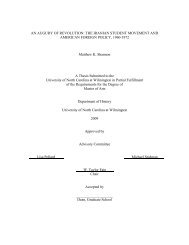Saprolegnia - The iLumina Digital Library
Saprolegnia - The iLumina Digital Library
Saprolegnia - The iLumina Digital Library
Create successful ePaper yourself
Turn your PDF publications into a flip-book with our unique Google optimized e-Paper software.
determinations) of isolates was not useful in separating the species that had been<br />
recognized classically on morphological grounds.<br />
In evaluating his observations and experimental data, Neish (1976) defined the<br />
<strong>Saprolegnia</strong> diclina-S. parasitica complex as one consisting of specimens with<br />
predominantly diclinous antheridial branches, and thin-walled, unpitted or<br />
inconspicuously pitted oogonia. He proposed (Neish, 1976:118) that the name parasitica<br />
be discarded as a nomen ambiguum, and a much-broadened interpretation of S. diclina be<br />
adopted.<br />
Detailed morphological analyses by Willoughby (1968b, 1969 1970, 1971a),<br />
Willoughby and Pickering (1977), and Pickering and Willoughby (1977) of watermolds<br />
associated with fish led to a decision that isolates could be grouped into types.<br />
Willoughby (1978) recognized three types of <strong>Saprolegnia</strong> diclina (parasitic forms from<br />
salmonids and perch, and strictly saprophytic ones) based upon the ratio of oogonium<br />
length to diameter. He concluded that it was impossible to maintain a two-species<br />
concept consisting of S. diclina and S. parasitica, and conserved the former name. We<br />
agree with his decision and are herewith formally reducing S. parasitica to synonymy.<br />
In his study on salmonid fish saprolegnians, Willoughby (1978) called attention<br />
to the fact that some isolates of the diclina-parasitica complex produced very extensive<br />
antheridial branches that closely invested the oogonia to which they were attached.<br />
Much earlier, Tiesenhausen (1912) had referred to profuse antheridial branch<br />
development, and illustrated clearly what Willoughby (1978: fig. 2e-h) was to refer to as<br />
a “bird nest” condition. We find the heavily enwrapped oogonia to be produced (Fig.<br />
99 F, G) in some specimens of S. diclina recovered from water and mud samples.<br />
Willoughby also discovered that the oospheres did not mature consistently. This<br />
condition recalls immediately the infrequency of mature oospores in S. australis, and<br />
strengthens the view that R. F. Elliott’s (1968) species might prove to be only a variant<br />
of S. diclina.<br />
In sum, it may be stated that a broadened, flexible interpretation of <strong>Saprolegnia</strong><br />
diclina emerges from an analysis of all the data at hand. Specimens isolated from fish<br />
may show profuse antheridial development, but sparse development is characteristic of<br />
other specimens. <strong>The</strong> same may be said for “saprophytic” (saprotrophic) forms of the<br />
species, as is shown by Willoughby’s (1978: fig. 4) S. diclina Type 3, and our own isolates<br />
from water (Fig. 99 G). With respect to oospore size -- Willoughby (1978) analyzed this<br />
character thoroughly in his specimens -- there is noticeable overlap and intergrading<br />
among isolates. It may be recalled, however, that the oospores of S. parasitica sensu<br />
Kanouse (1932) were smaller than those of S. diclina (sensu Seymour, 1970). This<br />
distinction fades when additional isolates are examined (see Willoughby, 1978, fig. 5).<br />
<strong>The</strong>re remains the troublesome matter of a name to be applied to the nonsexual<br />
specimens of <strong>Saprolegnia</strong> associated with fish. To these, of course, Coker (1923) had<br />
applied the name parasitica, and this subsequently was widely adopted even after<br />
Kanouse (loc. cit.) had discovered the sexual stage of individuals she chose to identify<br />
with Coker’s species. <strong>The</strong>re is no way to be certain that the watermolds studied by<br />
Kanouse were indeed identical to Coker’s specimens. In the final analysis, it appears to<br />
630
















